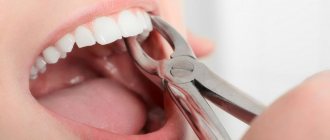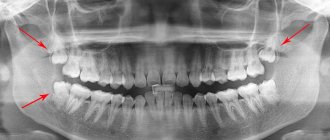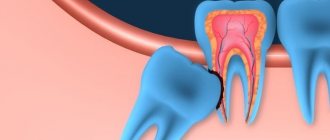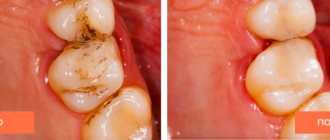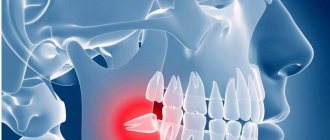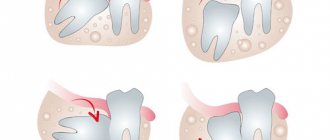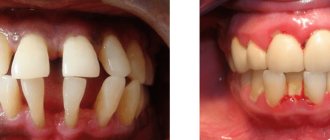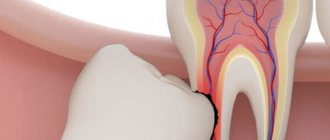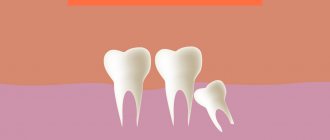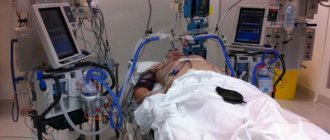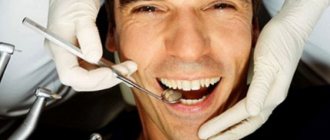Possible complications Indications for removal Why is it removed When can it not be removed?
Do eights heal? Removal of several teeth Treatment of complications Are eights treated? How to make eruption easier Wisdom teeth (eights, third molars) are the last units on each side of the dentition. They are the last to erupt, when the dental system is fully formed. And in most cases, their appearance causes a lot of problems. Since they often do not have enough space in a row, they grow incorrectly: at an angle, to the side, horizontally, they interfere with neighboring units, and injure the mucous membranes of the cheeks and tongue.
Whether wisdom teeth need to be removed depends on the clinical situation. The doctor will not remove third molars “just in case.” There must be medical indications for this. The anatomy of eights is more complex; these are the largest units in a row with a developed root system. Although they belong to the chewing group of teeth, they do not take part in the chewing process; this function is weakened or absent in units. The main function of third molars is to keep the teeth in the row from moving apart.
What problems may arise
- almost 80% of cases
, the eruption of third molars is accompanied by various purulent-inflammatory processes.
A mucous hood
is formed over the erupting unit , a pocket is created around it, where bacterial plaque and food debris accumulate, which leads to purulent inflammation -
pericoronitis
. - Often, figure eights grow towards the tongue, cheek, palate, constantly injuring the mucous membrane, causing a lot of painful and uncomfortable sensations. Chronic injury to soft tissues
can lead to the formation of ulcers, erosions, and the development of leukoplakia (hyperkeratosis) - the mucous membrane in the injured area becomes denser. If the cause (traumatic tooth) is not eliminated, there is a risk of neoplasm (including malignant). - Between 8 and 7 (on contact surfaces) a carious cavity is formed
where food is constantly clogged, contributing to the rapid development of caries. The carious process affects not only the number eight, but also the 7th molar, which is important for the dental apparatus. In case of interdental caries, it is necessary to remove the wisdom tooth and properly treat the seventh molar. - Sometimes the figure eight, positioned horizontally in the gum, rests on the root of a neighboring tooth, injuring it, causing the formation of a cyst
. In the worst case scenario, such a pathology can even lead to resection of the jaw bone. As a result of a long asymptomatic period, cysts can acquire significant sizes and damage the surrounding bone tissue and neighboring units. - Wisdom teeth can put serious pressure on adjacent units, moving them out of place. This pressure is transmitted to all teeth, causing row deformations
, malocclusion, and periodontal disease.
Patient reviews
Review 1
Before describing the procedure, I want to talk about my pain threshold. I can NOT stand pain. At all! I LOVE IT!!! For example, before treating caries, I ask you to give me 2 painkiller injections. And then one day my wisdom tooth began to hurt. I endured it steadfastly! But patience has come to an end! I had to go to the clinic.
Sitting down in a chair, I, as usual, asked for 2 injections and mentally prepared myself for torture :) Instead of somehow supporting and encouraging me, the doctor said: - Nahhh... but the tooth is in an inaccessible place! You can’t even get close to him!!!
Then she asked me to open it wider, then even wider, then again and again... It seemed to me that the corners of my mouth were already torn, and the doctor kept asking me to make my “mouth wider”! At the same time, she said, “What can I do here...” and tried to pick up the tooth with pliers.. These attempts lasted about 5 minutes. There was no particular pain, it was just unpleasant that the doctor could not pick up the tooth and was scared from waiting for the outcome. In the end, I asked: - Maybe I’ll go already?!!! If she can’t pick up a tooth, then WHAT will happen next?! To my deep surprise, the doctor did not even try to persuade me to stay and complete the procedure. She simply said: “Go!”
Well, wow :) This has never happened to me before. Usually doctors persuade: - Well, be patient... If you came, then you need to be patient. And here on you - go... I ask: - And what to do now? The answer was: “Nothing!” Rinse! And don't eat anything for 2 hours. And don't drink anything hot all day. - Why??? - Because the wound should heal. - So you REMOVED my tooth??? - Yes!
Just like that! While I was preparing for “medieval torture” and many hours of torment, the specialist did her job! BRAVO!!! I was delighted! After a couple of hours, the freezing sensation began to subside and the pain returned. She was tolerable, rinsing helped. After a few days the pain went away, but the wound healed for probably a whole month! The pain was weak and dull... The gums ached a little and as if something was pulling. But everything ended well! Everything is overgrown evenly.
Review 2
One of the four teeth had grown into the gum and began to rot there. Therefore, when I came to my favorite dentist, there was only one diagnosis - the wisdom tooth needed to be removed. I honestly couldn’t even get scared when I was already given anesthesia and the fragile dentist started pulling my tooth.
From the sensations, I can’t say that it hurt, no, the anesthesia worked well, but there was a feeling, I felt the tooth being taken with forceps, how it was being pulled, and I was even surprised how my fragile doctor pulled out this chunky tooth. He fought hard to get out, but for professionals there are no problems.
After this, of course, my gums bled a little, I was prescribed mouth rinses so that everything would heal faster. My gums healed within a day. I did not feel any discomfort due to the missing wisdom tooth.
Therefore, I can say for sure that the devil is not as scary as he is painted. Yes, it was unpleasant, but not painful and it could be tolerated. And if I have to remove the rest of my wisdom teeth, I won’t be the least bit upset or scared. Since there is nothing scary in this procedure.
In what cases is wisdom tooth removed?
The most common indication for surgical removal of third molars is their abnormal position.
or
difficult eruption
. In many cases, they remain inside the jawbone for a very long time, breaking through to the surface with difficulty, causing many problems. In such clinical situations, the maxillofacial surgeon performs a rather complex operation to extract the tooth from the bone tissue.
There are many reasons why wisdom teeth are removed. A direct indication for surgical extraction of the figure eight is:
- hygiene of third molars is difficult or impossible;
- caries, destruction of the coronal part;
- impacted molar (unerupted partially or completely);
- displacement of teeth in a row due to the growth of eights;
- dystopia (incorrect placement of 8s in a row) or traumatic occlusion;
- difficult access when treating adjacent units;
- location at an angle, promoting curvature and destruction of neighboring units;
- eruption beyond the boundaries of the dentition;
- germination of wisdom tooth roots into the maxillary sinus;
- the eruption of the figure eight caused complications (facial neuralgia);
- incomplete eruption with the presence of a hood of gingival mucosa.
Often, extraction of wisdom teeth is carried out for orthodontic indications, when, due to their abnormal position, the entire row begins to shift - the quadruples and incisors shift, forming crowding of the anterior group of dental units. With braces, wisdom teeth are removed to shorten the correction period and eliminate complications if figure eights begin to erupt during treatment.
Quality standards of the Doctor Levin center
Surgical operations, including multiple tooth extractions, in our Center are carried out in the LifeTime Warranty format, in strict accordance with the Center’s Unified Quality Standards.
An operation to remove all third molars in one day is possible if the following necessary conditions are met in the clinic : 3D computer diagnostics in ENT mode, a full-fledged anesthesiology department, thorough sanitation of the oral cavity, ultrasound surgical equipment, experienced adult surgeons on staff and professional postoperative service.
Why remove wisdom teeth
Third molars are rarely preserved - they are destroyed early or removal is necessary for the proper functioning of the dentition. Most dentists prefer to remove pathological 8 even before they can seriously harm the health of the jaw (especially the lower one) of the entire row.
Cannot be deleted
wisdom tooth in the absence of the 6th and 7th molars. A contraindication to extraction is inflammation of the periodontium, root, bone or gum, since there is a danger of spread and aggravation of the pathological process against the background of a postoperative wound. The limitations to surgical extraction of third molars are:
- location 8 in the area of malignancy;
- pregnancy;
- hypertension stage II-III;
- suffered a heart attack or stroke less than 3 months ago.
All operations, including dental ones, in these cases are carried out after consultation with the patient's attending physician.
When can they not be removed?
Modern dentistry clearly formulates its attitude towards figure eights - you don’t have to remove wisdom teeth provided:
- there is enough space for them to cut through;
- erupted molars occupy an anatomically correct position and do not harm neighboring units;
- nothing prevents the treatment of the eight;
- third molars do not impede hygienic care of teeth and gums;
- A wisdom tooth is needed as a support for fixing a bridge or other orthopedic system (if 7 is missing).
If the third molars are affected by caries, they somehow interfere with other units in the row or the chewing process, or regularly injure the mucous membrane - they must be removed. In this matter, world dentistry is ruthless; the presence of eights is allowed exactly as long as they do not harm the health of the dental system and do not disrupt its functionality.
Is it possible to remove several wisdom teeth at once?
It is possible to remove two wisdom teeth at once, but this is a certain stress for the body. More often, this operation is performed when it is necessary to remove the eights from one side (1 upper, 1 lower). This is done to maintain normal nutritional function. During surgical extraction, powerful anesthesia is used, so the operation is painless.
But after removing a large molar, a fairly large wound remains. Until it heals, the load on the operated area should be minimized; accordingly, you can chew on the side opposite the hole. If you remove both figure eights on the upper or lower jaw, eating will become problematic. And this affects the digestive system, immune system, and general health.
Easy removal
If the wisdom tooth has erupted correctly, grows evenly and has straight, untwisted roots, then there is every chance of getting by with a simple operation, which is carried out in 4 stages.
- Diagnostics
, including examination and x-ray, allows the doctor to get a more accurate idea of the upcoming operation. - Anesthesia.
Generally, local anesthesia is used for simple wisdom teeth removal. - Tooth extraction.
The doctor applies forceps, gently rocks the tooth and removes it using a special tool - an elevator. If fragments of roots remain in the hole, they are also carefully removed. - Treatment of the hole and suturing of the gums.
Antiseptic and anti-inflammatory solutions are used. In some cases, stitches are placed to protect the wound from bacteria, and the patient is sent back for rehabilitation. As reviews show, in the case of simple removal it takes very little time.
Treatment of complications with the growth of figure eights
The most common complication with the growth of figure eights is pericoronitis
(formation of a gum hood). When a molar erupts, it is forced to overcome many obstacles: the jaw bone, periosteum, and periodontal tissue. During long, complex eruption, a specific mucous canopy (hood) is formed over the molar. Bacteria and food particles penetrate under it, which causes inflammation.
If coronary artery disease is not treated, the consequences will be serious, the inflammation will spread to the periosteum and jaw bone. This is fraught with the development of periostitis, osteomyelitis, tissue suppuration with the formation of phlegmon, cysts, and fistula tracts. Nearby tissues may be affected, and inflammatory ENT pathologies (otitis media, sinusitis) may occur.
Treatment of pericoronitis is surgical and involves excision of the mucous hood. The operation opens access to the growing eight. The doctor removes the affected tissue, carefully treats the surgical area, and evaluates the clinical picture. According to the situation, he decides whether to remove the eights or help the molar to erupt completely, taking the correct place in the row.
